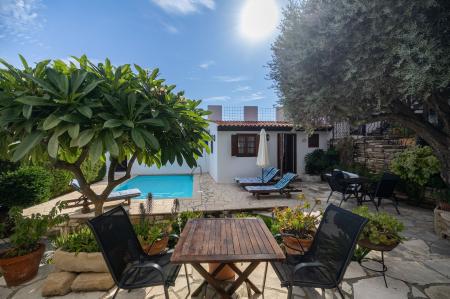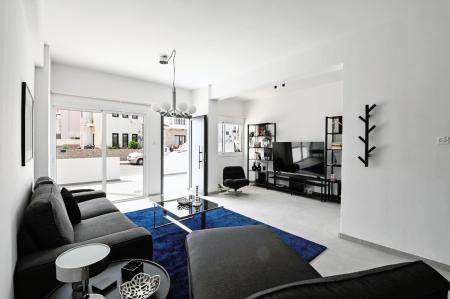Larnaca, situated on the south east coast of Cyprus, is the third largest city on the island. Built on the ancient ruins of Citium it has a history that dates back 4,000 years. Whilst rich in ancient culture, Larnaca is also a thriving, modern city and a popular tourist destination.
From stretches of varied coastline, a mix of traditional and cosmopolitan establishments and fascinating monuments, Larnaca seamlessly blends its two faces. The city center is home to the famous Finikoudes Beach, with its bustling seafront promenade lined with beautiful palm trees, restaurants, cafes and trendy beachfront bars. A short walk from the seafront you can visit the old Turkish Quarter (the Skala) where you can wander through the old narrow alleyways with their whitewashed buildings, some of them converted to shops selling traditional handmade pottery, sea sponges and local shells.
Larnaca’s rich history boasts a wealth of archaeological treasures and cultural landmarks such as The Larnaca Medieval Castle that stands proudly at the edge of the city’s promenade. The Church of Saint Lazarus is a must-see, a Byzantine-era church with its ornate architecture and religious significance.
Further inland, picturesque villages dot the countryside, offering a glimpse of traditional Cypriot life. The mountainous village of Lefkara is world-renowned for its traditional handicrafts of lace embroidery and filigree silver, which have been practiced in the village since Venetian times. Legend has it that the famous painter, Leonardo da Vinci himself visited the village in 1481 and bought a lace altar cloth, which he donated to Milan cathedral.
Looking to buy a property in Larnaca?
Browse through our collection of exquisite properties in the area.
Highlights and attractions
Ayios Lazaros Church

Located in its own square in the centre of town, the magnificent stone church of Agios Lazaros is one of the most remarkable examples of Byzantine architecture in Cyprus and lies over the tomb of the saint. Built by Byzantine Emperor Leo VI in the 9th century, the church was restored in the 17th century. Although the three domes and original bell tower of the church were destroyed in the first years during Ottoman rule, the gold-covered iconostasis has survived to today and is a superb example of baroque woodcarving.
Saint Lazarus came to Cyprus after being resurrected by Jesus. He was ordained as Bishop of Kition by the Apostles Barnabas and Paul and lived in the town for 30 years. His tomb can be seen under the sanctuary. The saint is so revered that a procession is held in his honour eight days before Easter. During the procession, the icon of Saint Lazarus is carried through the streets of Larnaka (Larnaca).
Next to the church is the Byzantine Museum, which exhibits important religious icons, artefacts and relics.
Larnaca Medieval Castle
Located at the end of the Foinikoudes promenade, the Medieval Castle of Larnaca (also referred to as Larnaca Fort) is believed to have been originally built during the Middle Ages, and took its present form during the Ottoman rule, although there is some contestation of its origins.
Chronographer Florius Boustronius dates it to the years of Lusignan King James I (1382 - 1398 AD), who built it to protect the harbour of the town. During the same time, the Genovese occupied Famagusta (Ammochostos) and the Lusignans had to develop another major port for the needs of their kingdom. Sources from the 18th century insist that the castle was built by the Turks in 1625 AD, even though a Turkish garrison was stationed there since 1570 AD. Other references by travellers confirm that the castle was constructed before 1625.
After the end of the Ottoman era in Cyprus, the British converted it into a prison and it was used during the first years of their rule. The western chamber of the ground floor in the east was used for the execution of prisoners. The gallows - which must had been constructed in the room - were in use until 1948.
Today, the castle houses the small Larnaka Medieval Museum across three rooms, and exhibits artefacts from the Early Christian period (4th-7th centuries) to the Ottoman period (18th-19th century).
Visit Larnaca Salt Lake

Larnaca Salt Lake is the second largest salt lake in Cyprus covering an area of 2.2 square kilometres. It is a protected Nature and Wildlife area under Cypriot Law and is a European Tamsar and Natura 2000 site.
During the winter months, as the lake fills with water, it becomes home to a variety of migratory birds, including thousands of flamingos, which transform the lake to amazing pink hues between November and March. It is also one of the most important habits in Europe for the waterfowl.
Visitors can explore the 4 kilometer nature trail which leads all the way up to the old aqueduct of Kamares. The abundance of flora, trees and shrubs are signposted with information along the way, and there are periodic resting benches, making the path ideal for walkers and joggers.
The Hala Sultan Tekke mosque is located on the west bank of the Salt Lake, where visitors can enter this important Islamic monument, one of the most revered sites in the Muslim world which is used to this day for religious purposes.
The mosque was built over the grave of Umm Haram or Ummü Haram, who was believed to be the sister of the Prophet Mohammed’s foster mother or a follower from Medina to Cyprus. Umm Haram arrived on the island either in 647 or 649, during the Arab raids led by the Arab Governor of Syria, Moawiya, in an effort to expand the Muslim empire in the Mediterranean Sea. However Umm Haram died shortly after her arrival and buried in the same place where she had fallen off her mule and died.
Do you need an expert to value your property?
Contact us for a no-obligation market appraisal.




